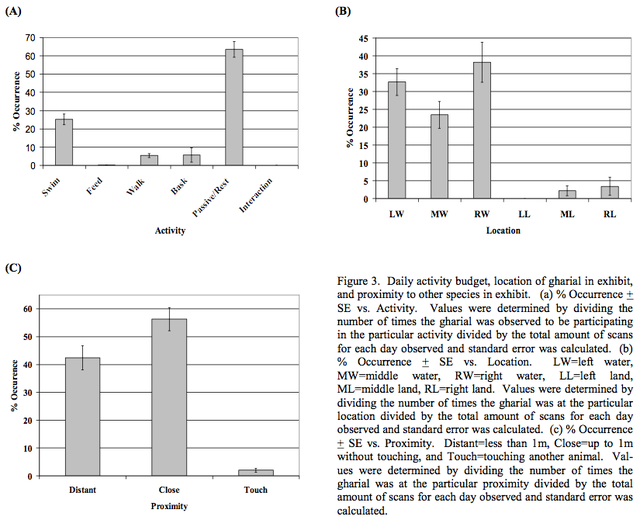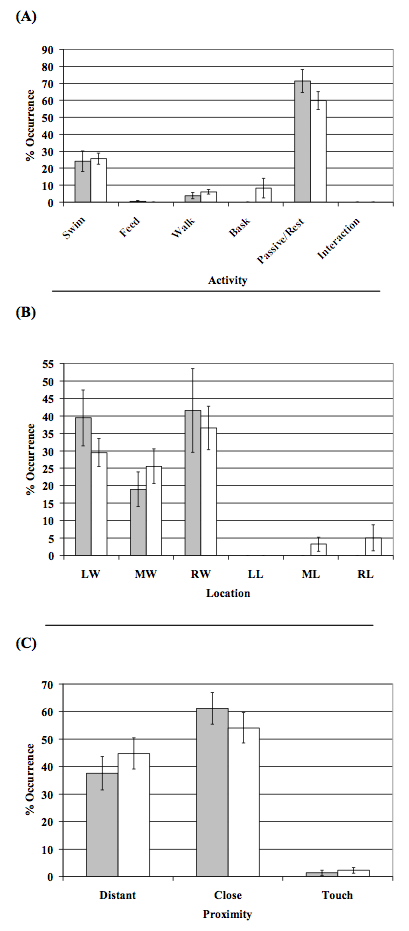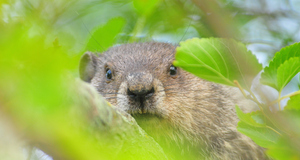From Discussions VOL. 4 NO. 1Gharial (Gavialis gangeticus) Habitat Use and Behavior Analysis in Response to Repeated AggressionRESULTSVery little all-occurrence behavior was seen. The gharial carried out one dominance display immediately after visitors walked by on one afternoon. The only other all-occurrence behavior was a jaw snap at a turtle after it had been swimming around the gharial's snout. In terms of overall activity, the gharial spent most of its time, about 64%, passive. However, 25% of its time was spent swimming (Fig. 3a). The gharial also spent some amount of its morning and afternoons walking in its enclosure and/or basking on the sand. Approximately 95% of its time was spent in water, which was consistent with the description of the species (Fig. 3b). Also, over half of the gharial‟s time was spent close to another species in the exhibit (Fig. 3c). It was noted that this was predominantly near the turtles, as they did not show any aversive behavior towards its presence. Time spent physically touching another animal was rare, usually observed when the gharial was resting on the bottom of the water and the turtle was either on top of the gharial or touching next to it, usually near the tail.
A point of interest is that its activity differed on days when the public was present and when it was not (Fig. 4a). From the graph one can see that less time was spent at rest when there were people present, which was also the only time in which the gharial was basking. Due to large standard error values, no conclusions can be made about its swimming and walking behavior, and statistics were not feasible due to small sample size. Both days with public present and days without shows that the gharial spent the previously mentioned majority of time in water (Fig. 4b); based purely upon observation, the gharial was viewed basking on land more often when the public was present (in the afternoon only) than when it was not. When the public was present the gharial spent slightly more time distant, but also more time in contact with the other species, though no large difference was noted (Fig. 4c). Figure 4. Activity budget, location of gharial in exhibit, and proximity to other species in exhibit on days with no public present (Filled bars) vs. days with public present (Open bars). (a) % Occurrence + SE vs. Activity. Values were determined by dividing the number of times the gharial was observed to be participating in the particular activity divided by the total amount of scans for each day observed and standard error was calculated. (b) % Occurrence + SE vs. Location. LW=left water, MW=middle water, RW=right water, LL=left land, ML=middle land, RL=right land. Values were determined by dividing the number of times the gharial was at the particular location divided by the total amount of scans for each day observed and standard error was calculated. (c) % Occurrence + SE vs. Proximity. Distant=less than 1m, Close=up to 1m without touching, and Touch=touching another animal. Values were determined by dividing the number of times the gharial was at the particular proximity divided by the total amount of scans for each day observed and standard error was calculated.
It was observed that the knifefish spent the majority of its time under the log, which was also under shadow, and the tinfoil barb frequently migrated to the opposite side of the exhibit that the gharial was on. On the days of observation when the zoo was open to the public, the gharial oriented itself towards the public 41% of the time. The subject was also observed to have performed less stereotypic behaviors when the public was present. When initial observations were taken and no visitors were present, it was noticed that the gharial had a patterned swim route. It was passive for a period of time in the right corner of the water, and then swam along the front-bottom portion of the water. It would then rest in the corner that bordered the left and middle water conditions explained previously, and then swim to where the bubbles emanated in the very left corner of the water and rest there. Afterwards it would return to the right side of the exhibit and begin again. Based on observation, this patterned swimming was seen less when the public was present.Continued on Next Page » Suggested Reading from Inquiries Journal
Inquiries Journal provides undergraduate and graduate students around the world a platform for the wide dissemination of academic work over a range of core disciplines. Representing the work of students from hundreds of institutions around the globe, Inquiries Journal's large database of academic articles is completely free. Learn more | Blog | Submit Latest in Biology |





















